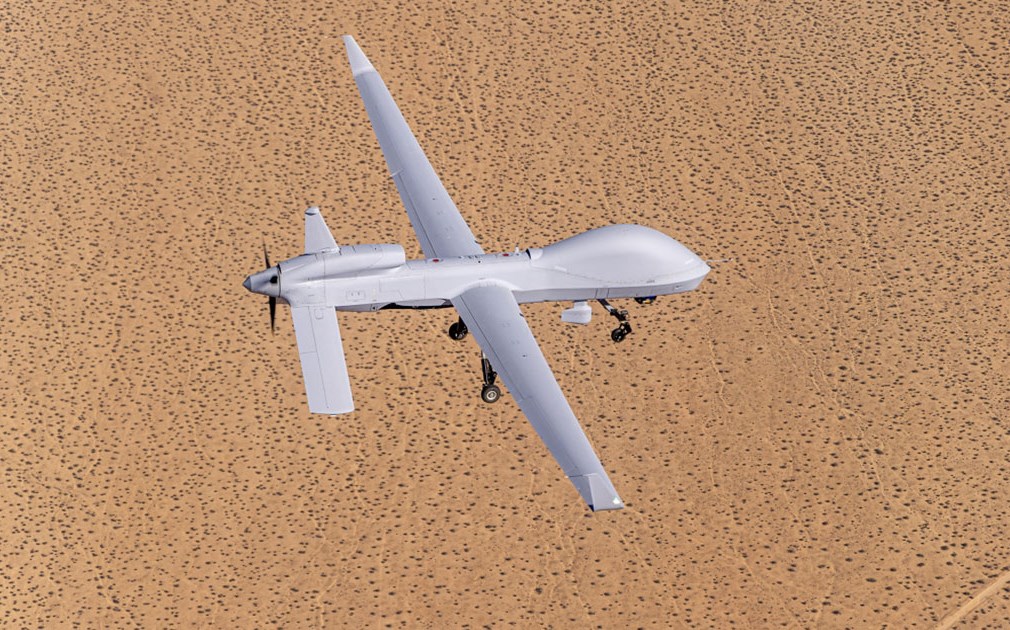On Friday, May 31, 2024, the American company General Atomics Aeronautical Systems (GA-ASI) announced that the U.S. Army has ordered another batch of combat unmanned aerial vehicles (UAVs), the MQ-1C-25M Gray Eagle Modernized Extended Range. Twelve of these aircraft will be delivered to the National Guard Aviation.
The funding for the contract (of the undisclosed value) comes from Congressional funds approved for the fiscal year 2023. The National Guard, which constitutes 45% of the US Army’s line components, requested funding for the purchase to standardize the fleet of unmanned systems. This is especially relevant in the context of multi-domain operations in collaboration with newly formed division-level artillery brigades. The MQ-1C Gray Eagle 25M in the National Guard will also be used for domestic missions such as national defense or responding to disasters and natural calamities. They are expected to be in service until 2050.
The first order for the MQ-1C Gray Eagle 25M was placed on December 1, 2023. For USD 389 million, an undisclosed number of aircrafts of this system, which is an advancement of the MQ-1C Gray Eagle, were ordered. Just four days later, the first production unit was flown. On May 9 of this year, a unit with the new HFE 2.0 (Heavy Fuel Engine) was flown, replacing the Lycoming DEL-120 HFE used in the prototype. By May 16, the end of the engine testing was announced. It was equipped with the EagleEye multi-mode radar and an electro-optical sensor.
“The Gray Eagle platform has a proven record of performance with over a million hours of safe operations, including automatic takeoff and landing capability,” said Patrick Shortsleeve, GA-ASI Vice President of Department of Defense Strategic Development . “The aircraft excels as an enabler for Fires, Maneuver, Network, and Intelligence operations. It is also an integral part of the Army Aviation team, working closely with manned rotary-wing systems to achieve overmatch against pacing threats.”
The unmanned aerial vehicle was originally designated as the Improved Gray Eagle (IGE). The prototype was first flown on July 27, 2013. It featured an increased flight endurance of up to 23 hours compared to the Block I version (14-15 hours). The aircraft received fuel tanks that were 50% larger, resulting in at least a 50% increase in payload capacity. It was also equipped with a new central underbelly hardpoint for carrying an additional 227 kg fuel tank or a pod with a 360-degree electro-optical sensor. The enlarged fuselage and improved engine leave room for further platform development.
On October 11, 2013, the Improved Gray Eagle prototype took off from GA-ASI’s El Mirage operational facility and flew continuously for 45.3 hours, landing on October 13. This was the first of two flight endurance demonstrations for the US Army. From January 11 to 19, 2014, the aircraft completed a second demonstration flight, lasting 36.7 hours. Unlike the previous test, during which it carried no payload, in this test, the aircraft flew with a SIGINT pod on one wing and two AGM-114 Hellfire anti-tank guided missiles on the other.
In July 2015, a plan to order 36 aircraft intended for US Army intelligence units and Special Operations Forces was announced. The first 19 IGE units were ordered in June 2015, with deliveries made between September 2017 and September 2018. The prototype was lost during a training exercise in early 2015. The production variant, designated MQ-1C Gray Eagle ER, had its first flight on October 29, 2016. The improved variant, Gray Eagle Extended Range, was delivered to the US Army for operational testing in 2018 and later received the final designation: MQ-1C-25M Gray Eagle Modernized Extended Range.
The base variant of the MQ-1C Gray Eagle was introduced into service in 2009 and was the result of the Extended-Range Multi-Purpose UAV program initiated in 2002, aimed at finding a successor to the RQ-5 Hunter (the prototype was first flown in October 2004). It was developed based on the MQ-1 Predator, which was designed for the US Air Force (USAF). A total of 204 units were produced.
Since 2014, thanks to the MUM-T (Manned-Unmanned Teaming) concept, MQ-1C can be controlled by the operator of an AH-64E Apache Guardian attack helicopter.






Comments
Nobody has commented on this article yet.